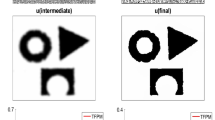Abstract
In this paper, we analyze the well-posedness of an image segmentation model. The main idea of that segmentation model is to minimize one energy functional by evolving a given piecewise constant image towards the image to be segmented. The evolution is controlled by a serial of mappings, which can be represented by B-spline basis functions. The evolution terminates when the energy is below a given threshold. We prove that the correspondence between two images in the segmentation model is an injective and surjective mapping under appropriate conditions. We further prove that the solution of the segmentation model exists using the direct method in the calculus of variations. These results provide the theoretical support for that segmentation model.
Similar content being viewed by others
References
Buck, R.C. Advanced Calculus. The McGraw-Hill Book Company, New York 1956
Caselles, V., Catte, F., Coll, T., Dibos, F. A geometric model for active contours in image processing. Numerische Mathematik, 66(1): 1–31 (1993)
Caselles, V., Kimmel, R., Sapiro, R. Geodesic active contours. International Journal of Computer Vision, 22: 61–79 (1997)
Chan, T.F., Sandberg, B.Y., Vese, L.A. Active contours without edges for vector-valued images. Journal of Visual Communication and Image Representation, 11: 130–141 (2000)
Chan, T.F., Vese, L.A. Active contours without edges. IEEE Transactions on Image Processing, 10(2): 266–277 (2001)
do Carmo, M.P. Differential Geometry of Curves and Surfaces. China Machine Press, Beijing, 2004
Esedoglu, S., Tsai, Y.H. Threshold dynamics for the piecewise constant Mumford-Shah functional. J. Comput. Phys., 211: 367–384 (2006)
Gibou, F., Fedkiw, R. A fast hybrid k-means level set algorithm for segmentation. In: 4th Annual Hawaii International Conference on Statistics and Mathematics, 2005, 281–291
Jing, Z.C., Li, M. A wavelet based alternative iteration method for the orientation refinement of cryoelectron microscopy 3D reconstruction. Mathematical Modelling and Analysis, 20(3): 396–408 (2015)
Jing, Z.C., Li, M.G., Wang, C.L. A Nonmonotone Line Search Based Algorithm for Distribution Center Location Selected. Acta Mathematicae Applicatae Sinica (English Series), 3: 699–706 (2014)
Kass, M., Witkin, A., Terzopoulos, D. Snakes: Active Contour Models. International Journal of Computer Vision, 1(4): 321–331 (1987)
Li, C., Xu, C., Gui, C., Fox, M.D. Level set evolution without re-initialization: a new variational formulation. In: Proc. of IEEE Conference on Computer Vision and Pattern Recognition, 2005, 430–436
Lie, J., Lysaker, M., Tai, X.C. A variant of the level set method and applications to image segmentation. Mathematics of Computation, 75: 1155–1174 (2006)
Linda, G. Shapiro, George, C. Stockman. Computer Vision. Prentice-Hall, Upper Saddle River, New Jersey, 2001
Malladi, R., Sethian, J.A., Vemuri, B.C. Shape modeling with front propagation: A level set approach. IEEE Transactions on Pattern Analysis and Machine Intelligence, 17(2): 158–175 (1995)
Massari, U., Tamanini, I. Regularity properties of optimal segmentations. J. Reine Angew. Math., 420: 61–84 (1991)
Mumford, D., Shah, J. Optimal approximations by piecewise smooth functions and associated variational problems. Communications on Pure and Applied Mathematics, 42: 577–685 (1989)
Munkres, J.R. Topology. China Machine Press, 2004
Song, B., Chan, T. A fast algorithm for level set based optimization. Cam report 02-68, UCLA, 2002
Sumengen, B., Manjunath, B. Graph partitioning active contours (GPAC) for image segmentation. IEEE Transactions on Pattern Analysis and Machine Intelligence, 28: 509–521 (2006)
Vese, L.A., Chanm, T.F. A multiphase level set framework for image segmentation using the Mumford and Shah model. International Journal of Computer Vision, 50: 271–293 (2002)
Ye, J., Xu, G. A geometric flow approach for region-based image segmentation. IEEE Transactions on Image Processing, 21(12): 4735–4745 (2012)
Zhang, G.Q. Functional Analysis Lecture. Peking University Press, Beijing, 1997
Ziemer, W.P. Image Processing and Analysis. Society for Industrial and Applied Mathematical, 2005
Author information
Authors and Affiliations
Corresponding author
Additional information
Project support in part by NSFC grant 61379096 and Chinese-Guangdong’s S & T project (2014A050503004).
Rights and permissions
About this article
Cite this article
Jing, Zc., Ye, J. & Xu, Gl. A geometric flow approach for region-based image segmentation-theoretical analysis. Acta Math. Appl. Sin. Engl. Ser. 34, 65–76 (2018). https://doi.org/10.1007/s10255-018-0723-4
Received:
Revised:
Published:
Issue Date:
DOI: https://doi.org/10.1007/s10255-018-0723-4




